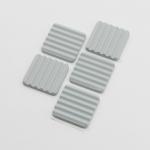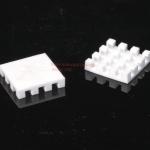Product Description:In the efficient operation of modern electronic devices, heat
dissipation is of crucial importance. As a high-performance heat
dissipation solution, ceramic heat sinks are gradually emerging and
have been widely used in numerous fields due to their unique
advantages. I. Material PropertiesCeramic heat sinks are mainly made of high-performance ceramic
materials such as alumina (Al₂O₃) and aluminum nitride (AlN). These
materials have excellent properties, laying a solid foundation for
the efficient operation of heat sinks. Taking alumina as an
example, 96% purity alumina ceramics can have a thermal
conductivity of 24 - 35W/m·K, which is more than 10 times that of
traditional epoxy resins, enabling rapid conduction of heat. At the
same time, its volume resistivity is >10¹⁴Ω·cm, and it can
withstand a high-voltage breakdown of up to 15kV. While ensuring
good thermal conductivity, it provides extremely high electrical
insulation, effectively preventing the risk of short circuits. In
addition, ceramic materials also have a high melting point. For
instance, the melting point of alumina ceramics is as high as
2054°C, which can remain stable in high-temperature environments
and ensure the continuous and normal operation of the heat sink. II. Heat Dissipation PrincipleThe heat dissipation principle of ceramic heat sinks is based on
their special structure and material properties. On one hand,
ceramics themselves have low heat capacity and do not store heat,
so heat can be quickly conducted to the outside through ceramics,
reducing the accumulation of heat inside the equipment. On the
other hand, some ceramic heat sinks adopt a micro-porous structure,
which can have 30% more porosity under the same unit area, greatly
increasing the contact area with convective media such as air,
significantly enhancing the heat convection effect, and thus being
able to take away more heat in the same unit time. Moreover, the
polycrystalline structure of ceramics further enhances the heat
dissipation capacity, surpassing most thermally conductive and
insulating materials available on the market under the same
conditions. III. Performance Advantages- Efficient Heat Dissipation: The high thermal conductivity allows ceramic heat sinks to
quickly conduct heat from the heating element to the outside,
effectively reducing the operating temperature of the equipment.
For example, in an actual test of a 5G base station, the chip
temperature dropped by 12°C after installing the ceramic heat sink,
strongly ensuring the stable operation of the base station
equipment.
- High Electrical Insulation: Excellent electrical insulation performance ensures that the heat
sink will not cause electrical faults such as short circuits in
high-voltage environments, providing reliable protection for the
safe operation of electronic equipment, especially suitable for
application scenarios with strict insulation requirements, such as
new energy vehicle battery modules.
- High Temperature Resistance and Corrosion Resistance: It can withstand high-temperature environments and has good
resistance to acids, alkalis and other chemical substances. It can
still maintain stable performance in harsh working environments,
greatly extending its service life. For example, in the application
of photovoltaic inverters, 99% alumina ceramic heat-conducting
sheets can work stably in a desert environment with a high
temperature of 70°C, much sand and wind, and strong ultraviolet
rays, while the traditional aluminum sheet heat dissipation scheme
has a sharp increase in thermal resistance due to oxidation.
- Anti-interference and Anti-static: It can effectively resist interference (EMI) and static
electricity, reduce the impact of external electromagnetic
interference on the equipment, and avoid damage to electronic
components caused by static electricity, improving the stability
and reliability of equipment operation.
- Small Size and Light Weight: While providing efficient heat dissipation, it occupies a small
space and is light in weight, conforming to the design trend of
modern equipment being thin, light, short and small, and
facilitating the compact layout and portable design of products.
- Environmental Protection: Ceramics are natural organic materials, which are environmentally
friendly during production and use, conforming to the current
environmental protection concepts and relevant environmental
protection requirements.
IV. Application Fields- Electronic Devices: Widely used in consumer electronic products such as mobile
phones, laptops, and tablet computers. For example, a certain
brand's flagship mobile phone embeds a 0.2mm alumina ceramic
heat-conducting sheet between the CPU and the shell. After playing
"Genshin Impact" for half an hour, the body temperature drops from
48°C to 36°C, and the frame rate is stable at 60fps, significantly
improving the user's gaming experience. In laptops, ceramic heat
sinks replace traditional thermal grease, reducing the volume of
the heat dissipation module by 30%, creating conditions for thin
and light laptops to be equipped with standard-voltage CPUs.
- New Energy Vehicles: It is crucial for the thermal management of batteries. Tesla's
4680 battery pack uses porous ceramic heat-conducting sheets with a
thermal conductivity of 30W/m·K. Combined with the liquid cooling
system, the temperature difference of the battery cells is
controlled within ±2°C, effectively reducing the risk of battery
thermal runaway. A domestic automaker's actual measurement shows
that the probability of thermal runaway of the battery pack without
ceramic sheets during fast charging is 8 times that of the one with
ceramic sheets installed.
- Photovoltaic Inverters: In photovoltaic power stations, inverters generate a lot of heat
during long-term operation. The inverters in Dunhuang Photovoltaic
Power Station use 99% alumina ceramic heat-conducting sheets, which
can still work stably in harsh environments with high temperature,
strong ultraviolet rays and much sand and wind, ensuring the
efficient power generation of the photovoltaic system.
- Semiconductor Manufacturing: In applications such as wafer lithography equipment carriers,
nano-scale alumina ceramic heat-conducting sheets can achieve a
temperature control accuracy of ±0.01°C, ensuring that temperature
fluctuations do not affect circuit accuracy during photoresist
exposure, and improving the yield rate of chip manufacturing.
According to data from a packaging factory, the chip yield rate
increased by 3.2% after using ceramic heat-conducting sheets.
- Other Fields: It is also widely used in set-top boxes, LED lights,
high-frequency welding machines, power amplifiers/speakers, power
transistors, power modules, inverters, network/broadband, UPS power
supplies and other equipment, as well as aerospace, industrial
manufacturing and other fields with high requirements for heat
dissipation and material performance, providing reliable heat
dissipation protection for the stable operation of various
equipment.
V. Customization ServicesWe are well aware that different customers have different needs, so
we provide comprehensive customization services. Whether it is
size, shape, or material selection, we can tailor-make according to
your specific requirements. From common standard sizes such as TO -
220, TO - 247, TO - 264, TO - 3P to various non-standard sizes, we
can produce accurately. At the same time, according to your
emphasis on different performance indicators such as heat
dissipation performance, electrical insulation, and temperature
resistance, we can recommend and select the most suitable ceramic
materials, such as alumina and aluminum nitride, and optimize the
materials to meet your specific application scenarios. With its excellent performance and wide applicability, ceramic heat
sinks provide an ideal solution for solving the heat dissipation
problems of modern equipment. Choosing our ceramic heat sinks means
choosing efficient, safe and reliable heat dissipation protection,
which can guarantee the performance improvement and stable
operation of your equipment.
Features:- Product Name: Ceramic Heat Sink
- Temperature Resistance: <700℃
- Surface Roughness: 0.3-0.8 Um
- Density: 3.7g/cm^3
- Material: Ceramic, SiC, Al₂O₃, SiO₂, Al₄C₃
- Mechanical Strength: ≥3000MPa
- Low cost
- Not affected by humidity and dust
- No antennae effect
Technical Parameters:| Surface Roughness | 0.3-0.8 Um | | Insulation Strength | >=15KV/mm | | Durability | Long-lasting | | Material | Ceramic, SiC, Al₂O₃, SiO₂, Al₄C₃ | | Density | 3.7g/cm³ | | Thermal Conductivity | 9-180 MW/m.K | | Color | Green, Black, White, Gray | | Mechanical Strength | >=3000MPa | | Heat Dissipation | Efficient | | Size | Various Sizes Available | | Adhesive Tape | With and without thermally conductive Silicone adhesive tape | | EMI Issues | No Electromagnetic Interference (EMI) issues | | Antennae Effect | No antennae effect |
Applications:The Ceramic Heat Sink/Ceramic Micro Porous Heat Sink has a large
surface area compared to Aluminium Heat Sinks, resulting in better
heat dissipation. Its lightweight design makes it easy to install
and handle. With a temperature resistance of less than 700℃ and a
density of 3.7g/cm^3, this product is ideal for applications that
require high-temperature resistance and high-density power. This product can be used with various electronic devices such as
Transistors, MOSFETs, Schottky Diodes, IGBTs, high-density
switching power supplies, high-frequency communication signal
equipment, high-frequency welding machines, and other electronic
devices. Its power dissipation of up to 10W makes it suitable for
high-performance applications. At Race, we offer packaging options as per customer requirements
and a delivery time of 7-15 days. Payment terms are 30% TT in
advance, and the balance payment is paid before shipment. The
Ceramic Heat Sink/Ceramic Micro Porous Heat Sink is available in
green, black, white, and gray colors, giving our customers the
opportunity to choose the color that best suits their device. |









